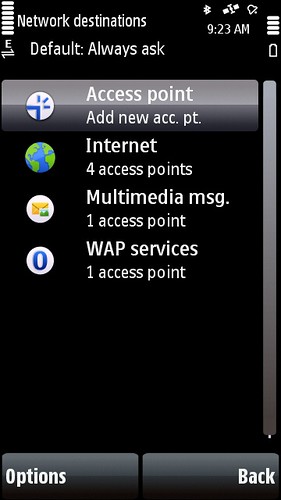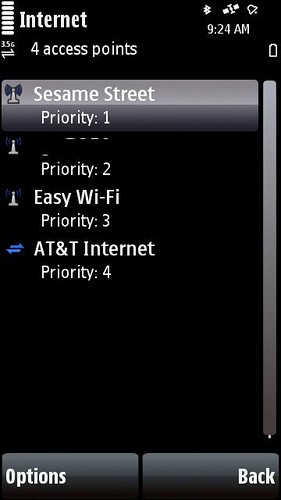Nokia has been making some very nice though admittedly subtle updates to the way the S60 functions on the later devices and having used most of them I’ve been taking this for granted. Starting in Feature Pack 2 (N85, N79) the Network Setting panel received an update which added something called Destinations. Destinations are a way to group access points like your cellular data and wifi into a group. This group function is actually an old function that used to exist in early Eseries devices (E61) and was awesome, but never seemed to carry forward to later ones like the E71. Gotta love the consistency …
Since using the Nokia 5800 I’ve noticed something about how these Destinations now work and it’s a very powerful concept and one that should really be part of all smart devices. With wifi scanning on (I set mine to a 10 min interval), my phone will automatically switch over to wifi when in range. The 5800 runs the 5th edition version of S60 which is what the upcoming N97 runs so this will also work there. Connection switching back to cellular has not been as smooth in my experience, but it does work. In classic form (and yes that is sarcasm) S60 is not set to use a Destination for all applications. Instead some applications rely on an Access Point which makes the switching impossible. New apps like the Nokia Messaging service looks to use Default which will drop to Internet (the main Destination) though MailForExchange needs a single Access Point. The browser is happy with a Destination though Gravity (a 3rd party twitter app) wants an Access Point. Google Maps wants an Access Point … you get the idea.
These subtle changes are powerful but frustrating as even Nokia’s core applications cannot take best advantage of the work that’s been done to improve the user experience. As a non-developer it’s hard to know whether these updates get pushed out in a reasonable way to encourage adoption or whether developers are left to figure it out for themselves just like the user. It’s getting better, but clearly quite a bit of work still lies ahead.


